Meat Consumption Trends and Health Implications in New Zealand
VerifiedAdded on 2021/05/31
|10
|2011
|40
Report
AI Summary
This report provides an analysis of meat consumption patterns in New Zealand, exploring the associated health implications. The study highlights the high consumption of processed meats and its link to various health concerns, including cancer, cardiovascular disease, and fatty liver disease. It reviews existing literature, discussing the risks of red and processed meat consumption and the potential benefits of vegan diets. The report emphasizes the need for public health interventions, such as health education campaigns and dietary modifications, to reduce meat consumption and promote healthier eating habits. It also touches on the environmental and food security concerns related to meat production and consumption, advocating for a shift towards more sustainable dietary practices. The report suggests that governmental policies, such as taxation on processed meats and promotion of plant-based foods, can play a crucial role in influencing dietary behavior and improving public health outcomes.
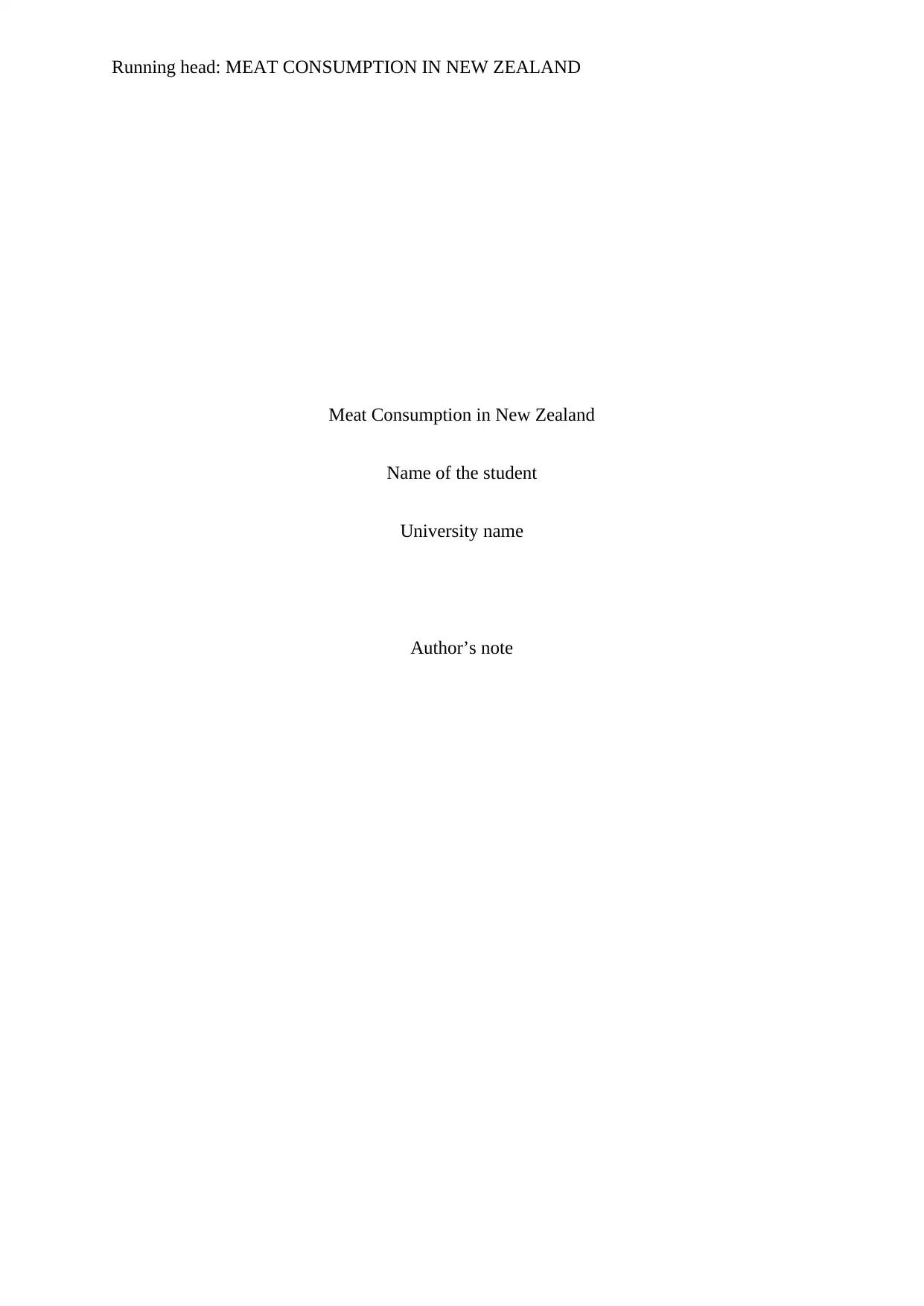
Running head: MEAT CONSUMPTION IN NEW ZEALAND
Meat Consumption in New Zealand
Name of the student
University name
Author’s note
Meat Consumption in New Zealand
Name of the student
University name
Author’s note
Paraphrase This Document
Need a fresh take? Get an instant paraphrase of this document with our AI Paraphraser
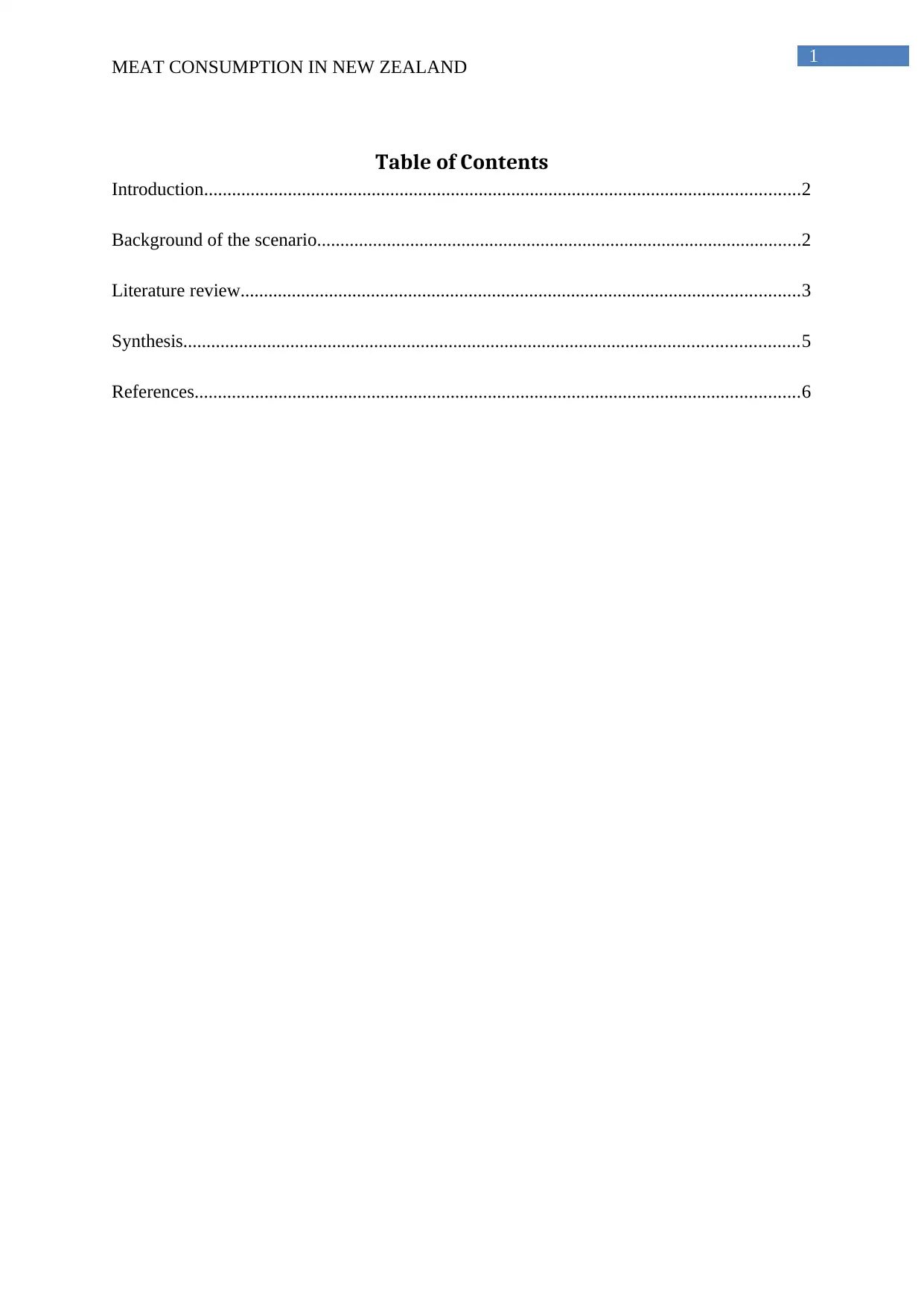
1
MEAT CONSUMPTION IN NEW ZEALAND
Table of Contents
Introduction................................................................................................................................2
Background of the scenario........................................................................................................2
Literature review........................................................................................................................3
Synthesis....................................................................................................................................5
References..................................................................................................................................6
MEAT CONSUMPTION IN NEW ZEALAND
Table of Contents
Introduction................................................................................................................................2
Background of the scenario........................................................................................................2
Literature review........................................................................................................................3
Synthesis....................................................................................................................................5
References..................................................................................................................................6
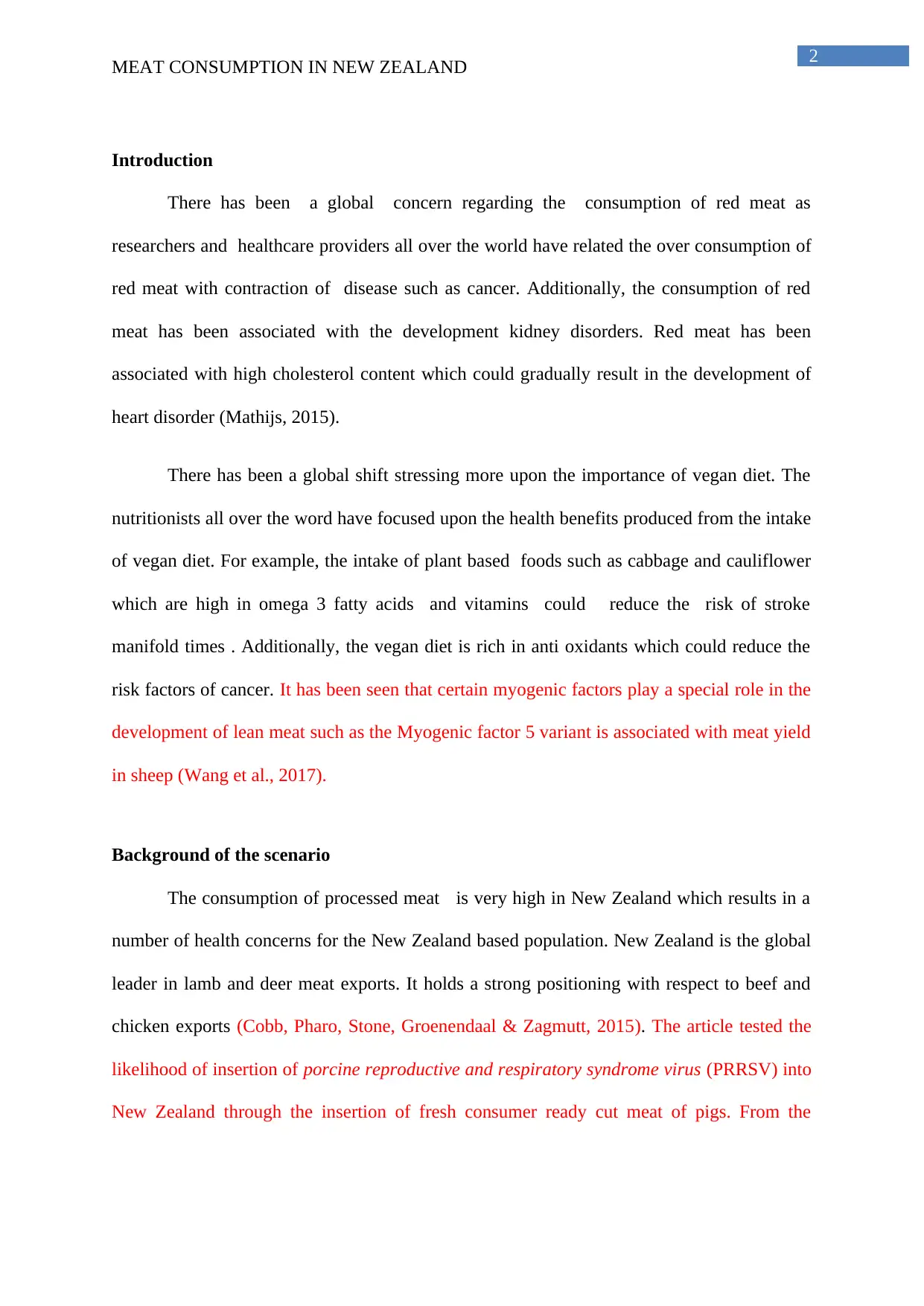
2
MEAT CONSUMPTION IN NEW ZEALAND
Introduction
There has been a global concern regarding the consumption of red meat as
researchers and healthcare providers all over the world have related the over consumption of
red meat with contraction of disease such as cancer. Additionally, the consumption of red
meat has been associated with the development kidney disorders. Red meat has been
associated with high cholesterol content which could gradually result in the development of
heart disorder (Mathijs, 2015).
There has been a global shift stressing more upon the importance of vegan diet. The
nutritionists all over the word have focused upon the health benefits produced from the intake
of vegan diet. For example, the intake of plant based foods such as cabbage and cauliflower
which are high in omega 3 fatty acids and vitamins could reduce the risk of stroke
manifold times . Additionally, the vegan diet is rich in anti oxidants which could reduce the
risk factors of cancer. It has been seen that certain myogenic factors play a special role in the
development of lean meat such as the Myogenic factor 5 variant is associated with meat yield
in sheep (Wang et al., 2017).
Background of the scenario
The consumption of processed meat is very high in New Zealand which results in a
number of health concerns for the New Zealand based population. New Zealand is the global
leader in lamb and deer meat exports. It holds a strong positioning with respect to beef and
chicken exports (Cobb, Pharo, Stone, Groenendaal & Zagmutt, 2015). The article tested the
likelihood of insertion of porcine reproductive and respiratory syndrome virus (PRRSV) into
New Zealand through the insertion of fresh consumer ready cut meat of pigs. From the
MEAT CONSUMPTION IN NEW ZEALAND
Introduction
There has been a global concern regarding the consumption of red meat as
researchers and healthcare providers all over the world have related the over consumption of
red meat with contraction of disease such as cancer. Additionally, the consumption of red
meat has been associated with the development kidney disorders. Red meat has been
associated with high cholesterol content which could gradually result in the development of
heart disorder (Mathijs, 2015).
There has been a global shift stressing more upon the importance of vegan diet. The
nutritionists all over the word have focused upon the health benefits produced from the intake
of vegan diet. For example, the intake of plant based foods such as cabbage and cauliflower
which are high in omega 3 fatty acids and vitamins could reduce the risk of stroke
manifold times . Additionally, the vegan diet is rich in anti oxidants which could reduce the
risk factors of cancer. It has been seen that certain myogenic factors play a special role in the
development of lean meat such as the Myogenic factor 5 variant is associated with meat yield
in sheep (Wang et al., 2017).
Background of the scenario
The consumption of processed meat is very high in New Zealand which results in a
number of health concerns for the New Zealand based population. New Zealand is the global
leader in lamb and deer meat exports. It holds a strong positioning with respect to beef and
chicken exports (Cobb, Pharo, Stone, Groenendaal & Zagmutt, 2015). The article tested the
likelihood of insertion of porcine reproductive and respiratory syndrome virus (PRRSV) into
New Zealand through the insertion of fresh consumer ready cut meat of pigs. From the
⊘ This is a preview!⊘
Do you want full access?
Subscribe today to unlock all pages.

Trusted by 1+ million students worldwide
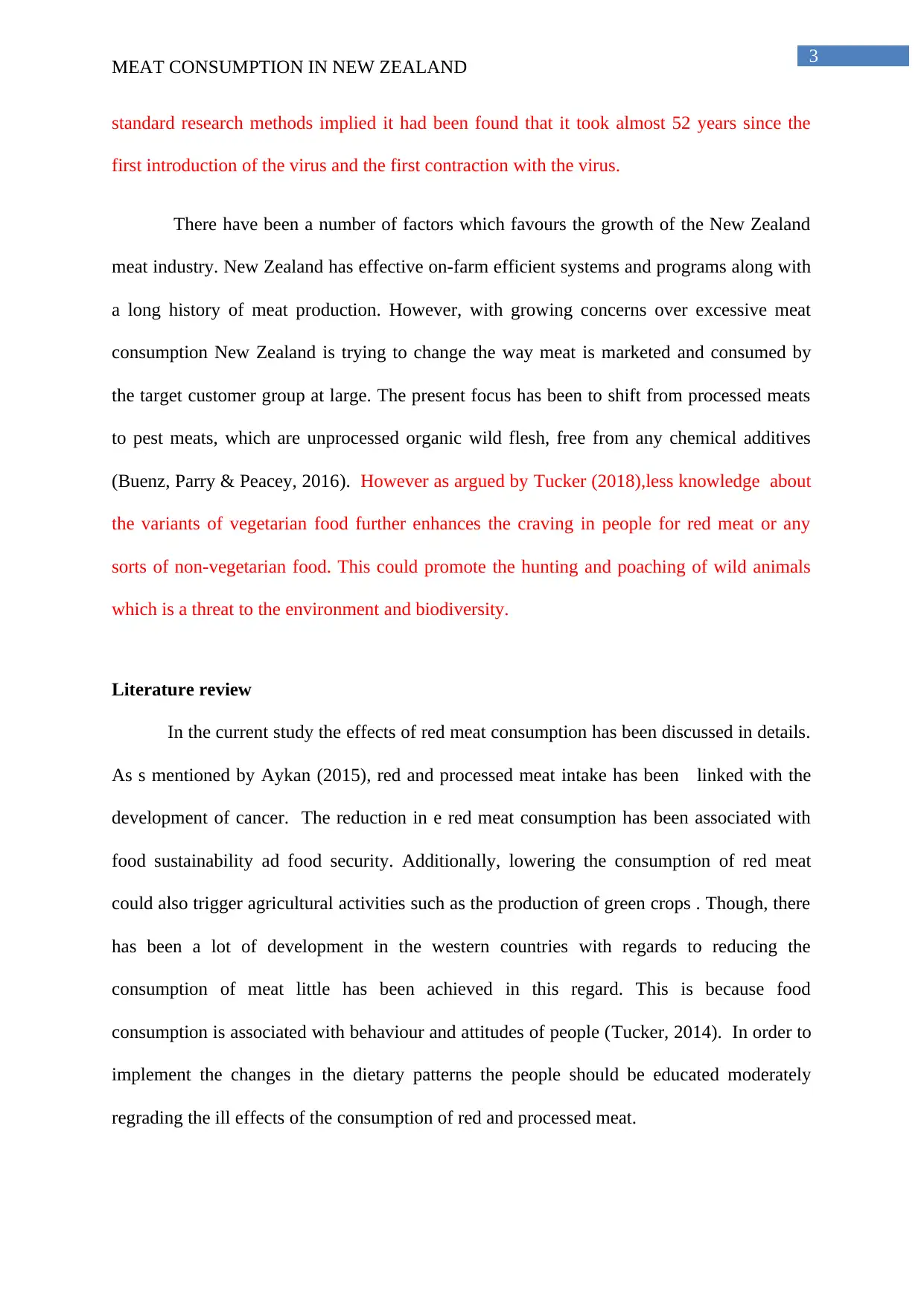
3
MEAT CONSUMPTION IN NEW ZEALAND
standard research methods implied it had been found that it took almost 52 years since the
first introduction of the virus and the first contraction with the virus.
There have been a number of factors which favours the growth of the New Zealand
meat industry. New Zealand has effective on-farm efficient systems and programs along with
a long history of meat production. However, with growing concerns over excessive meat
consumption New Zealand is trying to change the way meat is marketed and consumed by
the target customer group at large. The present focus has been to shift from processed meats
to pest meats, which are unprocessed organic wild flesh, free from any chemical additives
(Buenz, Parry & Peacey, 2016). However as argued by Tucker (2018),less knowledge about
the variants of vegetarian food further enhances the craving in people for red meat or any
sorts of non-vegetarian food. This could promote the hunting and poaching of wild animals
which is a threat to the environment and biodiversity.
Literature review
In the current study the effects of red meat consumption has been discussed in details.
As s mentioned by Aykan (2015), red and processed meat intake has been linked with the
development of cancer. The reduction in e red meat consumption has been associated with
food sustainability ad food security. Additionally, lowering the consumption of red meat
could also trigger agricultural activities such as the production of green crops . Though, there
has been a lot of development in the western countries with regards to reducing the
consumption of meat little has been achieved in this regard. This is because food
consumption is associated with behaviour and attitudes of people (Tucker, 2014). In order to
implement the changes in the dietary patterns the people should be educated moderately
regrading the ill effects of the consumption of red and processed meat.
MEAT CONSUMPTION IN NEW ZEALAND
standard research methods implied it had been found that it took almost 52 years since the
first introduction of the virus and the first contraction with the virus.
There have been a number of factors which favours the growth of the New Zealand
meat industry. New Zealand has effective on-farm efficient systems and programs along with
a long history of meat production. However, with growing concerns over excessive meat
consumption New Zealand is trying to change the way meat is marketed and consumed by
the target customer group at large. The present focus has been to shift from processed meats
to pest meats, which are unprocessed organic wild flesh, free from any chemical additives
(Buenz, Parry & Peacey, 2016). However as argued by Tucker (2018),less knowledge about
the variants of vegetarian food further enhances the craving in people for red meat or any
sorts of non-vegetarian food. This could promote the hunting and poaching of wild animals
which is a threat to the environment and biodiversity.
Literature review
In the current study the effects of red meat consumption has been discussed in details.
As s mentioned by Aykan (2015), red and processed meat intake has been linked with the
development of cancer. The reduction in e red meat consumption has been associated with
food sustainability ad food security. Additionally, lowering the consumption of red meat
could also trigger agricultural activities such as the production of green crops . Though, there
has been a lot of development in the western countries with regards to reducing the
consumption of meat little has been achieved in this regard. This is because food
consumption is associated with behaviour and attitudes of people (Tucker, 2014). In order to
implement the changes in the dietary patterns the people should be educated moderately
regrading the ill effects of the consumption of red and processed meat.
Paraphrase This Document
Need a fresh take? Get an instant paraphrase of this document with our AI Paraphraser
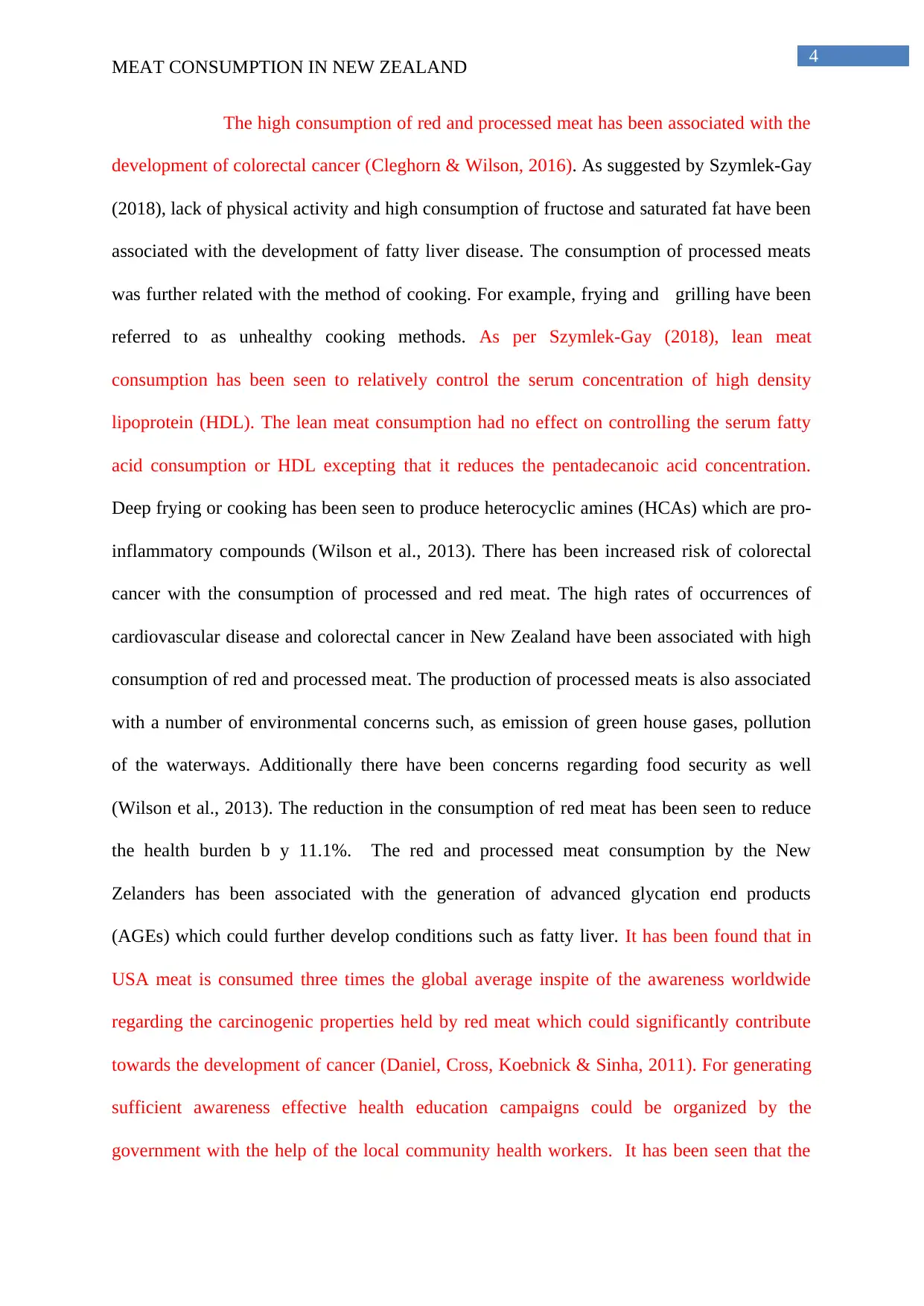
4
MEAT CONSUMPTION IN NEW ZEALAND
The high consumption of red and processed meat has been associated with the
development of colorectal cancer (Cleghorn & Wilson, 2016). As suggested by Szymlek-Gay
(2018), lack of physical activity and high consumption of fructose and saturated fat have been
associated with the development of fatty liver disease. The consumption of processed meats
was further related with the method of cooking. For example, frying and grilling have been
referred to as unhealthy cooking methods. As per Szymlek-Gay (2018), lean meat
consumption has been seen to relatively control the serum concentration of high density
lipoprotein (HDL). The lean meat consumption had no effect on controlling the serum fatty
acid consumption or HDL excepting that it reduces the pentadecanoic acid concentration.
Deep frying or cooking has been seen to produce heterocyclic amines (HCAs) which are pro-
inflammatory compounds (Wilson et al., 2013). There has been increased risk of colorectal
cancer with the consumption of processed and red meat. The high rates of occurrences of
cardiovascular disease and colorectal cancer in New Zealand have been associated with high
consumption of red and processed meat. The production of processed meats is also associated
with a number of environmental concerns such, as emission of green house gases, pollution
of the waterways. Additionally there have been concerns regarding food security as well
(Wilson et al., 2013). The reduction in the consumption of red meat has been seen to reduce
the health burden b y 11.1%. The red and processed meat consumption by the New
Zelanders has been associated with the generation of advanced glycation end products
(AGEs) which could further develop conditions such as fatty liver. It has been found that in
USA meat is consumed three times the global average inspite of the awareness worldwide
regarding the carcinogenic properties held by red meat which could significantly contribute
towards the development of cancer (Daniel, Cross, Koebnick & Sinha, 2011). For generating
sufficient awareness effective health education campaigns could be organized by the
government with the help of the local community health workers. It has been seen that the
MEAT CONSUMPTION IN NEW ZEALAND
The high consumption of red and processed meat has been associated with the
development of colorectal cancer (Cleghorn & Wilson, 2016). As suggested by Szymlek-Gay
(2018), lack of physical activity and high consumption of fructose and saturated fat have been
associated with the development of fatty liver disease. The consumption of processed meats
was further related with the method of cooking. For example, frying and grilling have been
referred to as unhealthy cooking methods. As per Szymlek-Gay (2018), lean meat
consumption has been seen to relatively control the serum concentration of high density
lipoprotein (HDL). The lean meat consumption had no effect on controlling the serum fatty
acid consumption or HDL excepting that it reduces the pentadecanoic acid concentration.
Deep frying or cooking has been seen to produce heterocyclic amines (HCAs) which are pro-
inflammatory compounds (Wilson et al., 2013). There has been increased risk of colorectal
cancer with the consumption of processed and red meat. The high rates of occurrences of
cardiovascular disease and colorectal cancer in New Zealand have been associated with high
consumption of red and processed meat. The production of processed meats is also associated
with a number of environmental concerns such, as emission of green house gases, pollution
of the waterways. Additionally there have been concerns regarding food security as well
(Wilson et al., 2013). The reduction in the consumption of red meat has been seen to reduce
the health burden b y 11.1%. The red and processed meat consumption by the New
Zelanders has been associated with the generation of advanced glycation end products
(AGEs) which could further develop conditions such as fatty liver. It has been found that in
USA meat is consumed three times the global average inspite of the awareness worldwide
regarding the carcinogenic properties held by red meat which could significantly contribute
towards the development of cancer (Daniel, Cross, Koebnick & Sinha, 2011). For generating
sufficient awareness effective health education campaigns could be organized by the
government with the help of the local community health workers. It has been seen that the
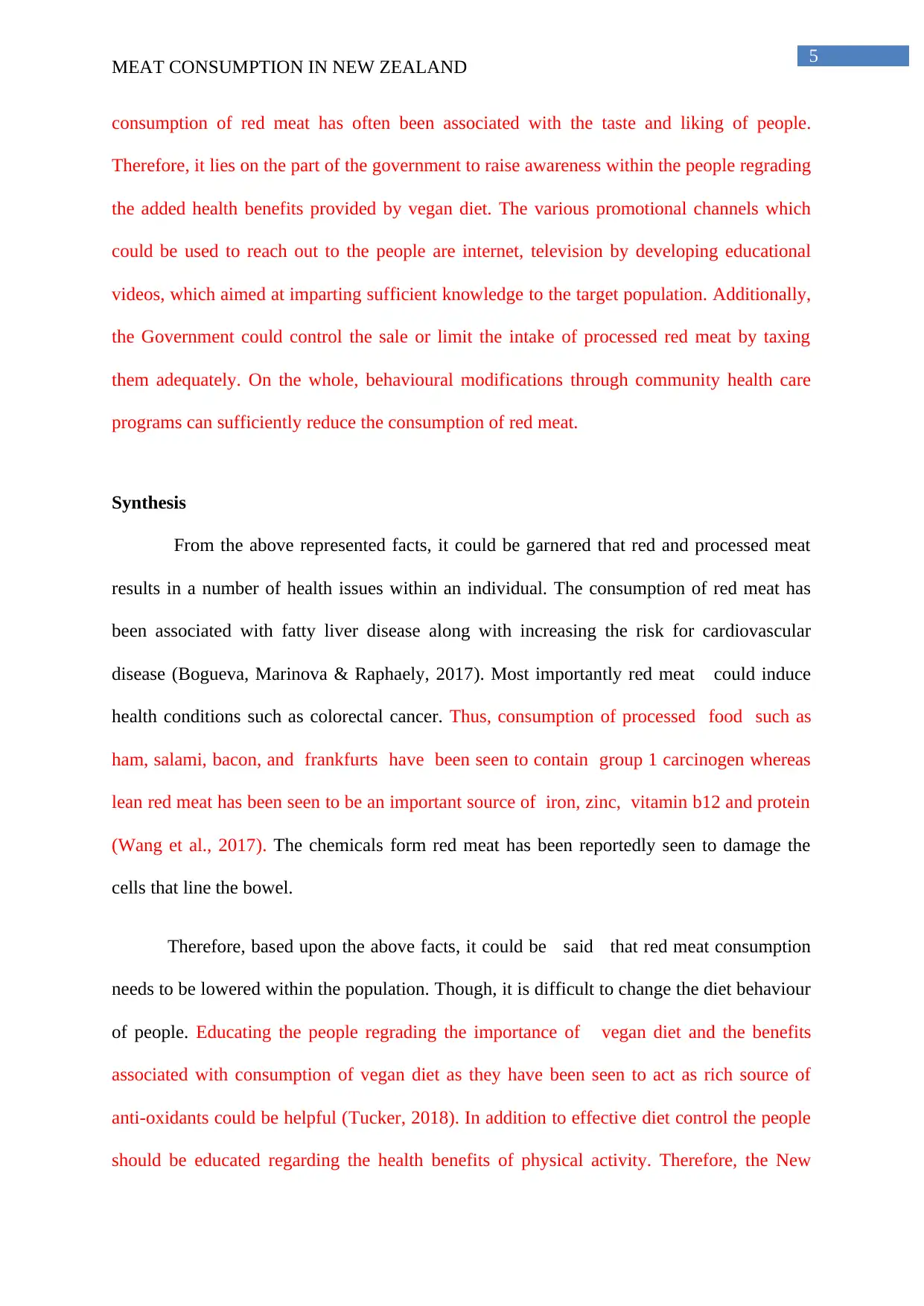
5
MEAT CONSUMPTION IN NEW ZEALAND
consumption of red meat has often been associated with the taste and liking of people.
Therefore, it lies on the part of the government to raise awareness within the people regrading
the added health benefits provided by vegan diet. The various promotional channels which
could be used to reach out to the people are internet, television by developing educational
videos, which aimed at imparting sufficient knowledge to the target population. Additionally,
the Government could control the sale or limit the intake of processed red meat by taxing
them adequately. On the whole, behavioural modifications through community health care
programs can sufficiently reduce the consumption of red meat.
Synthesis
From the above represented facts, it could be garnered that red and processed meat
results in a number of health issues within an individual. The consumption of red meat has
been associated with fatty liver disease along with increasing the risk for cardiovascular
disease (Bogueva, Marinova & Raphaely, 2017). Most importantly red meat could induce
health conditions such as colorectal cancer. Thus, consumption of processed food such as
ham, salami, bacon, and frankfurts have been seen to contain group 1 carcinogen whereas
lean red meat has been seen to be an important source of iron, zinc, vitamin b12 and protein
(Wang et al., 2017). The chemicals form red meat has been reportedly seen to damage the
cells that line the bowel.
Therefore, based upon the above facts, it could be said that red meat consumption
needs to be lowered within the population. Though, it is difficult to change the diet behaviour
of people. Educating the people regrading the importance of vegan diet and the benefits
associated with consumption of vegan diet as they have been seen to act as rich source of
anti-oxidants could be helpful (Tucker, 2018). In addition to effective diet control the people
should be educated regarding the health benefits of physical activity. Therefore, the New
MEAT CONSUMPTION IN NEW ZEALAND
consumption of red meat has often been associated with the taste and liking of people.
Therefore, it lies on the part of the government to raise awareness within the people regrading
the added health benefits provided by vegan diet. The various promotional channels which
could be used to reach out to the people are internet, television by developing educational
videos, which aimed at imparting sufficient knowledge to the target population. Additionally,
the Government could control the sale or limit the intake of processed red meat by taxing
them adequately. On the whole, behavioural modifications through community health care
programs can sufficiently reduce the consumption of red meat.
Synthesis
From the above represented facts, it could be garnered that red and processed meat
results in a number of health issues within an individual. The consumption of red meat has
been associated with fatty liver disease along with increasing the risk for cardiovascular
disease (Bogueva, Marinova & Raphaely, 2017). Most importantly red meat could induce
health conditions such as colorectal cancer. Thus, consumption of processed food such as
ham, salami, bacon, and frankfurts have been seen to contain group 1 carcinogen whereas
lean red meat has been seen to be an important source of iron, zinc, vitamin b12 and protein
(Wang et al., 2017). The chemicals form red meat has been reportedly seen to damage the
cells that line the bowel.
Therefore, based upon the above facts, it could be said that red meat consumption
needs to be lowered within the population. Though, it is difficult to change the diet behaviour
of people. Educating the people regrading the importance of vegan diet and the benefits
associated with consumption of vegan diet as they have been seen to act as rich source of
anti-oxidants could be helpful (Tucker, 2018). In addition to effective diet control the people
should be educated regarding the health benefits of physical activity. Therefore, the New
⊘ This is a preview!⊘
Do you want full access?
Subscribe today to unlock all pages.

Trusted by 1+ million students worldwide

6
MEAT CONSUMPTION IN NEW ZEALAND
Zealand government should promote more intake of vegetable rich diet and provide free
supply of fresh fruits and vegetables in rural areas.
MEAT CONSUMPTION IN NEW ZEALAND
Zealand government should promote more intake of vegetable rich diet and provide free
supply of fresh fruits and vegetables in rural areas.
Paraphrase This Document
Need a fresh take? Get an instant paraphrase of this document with our AI Paraphraser
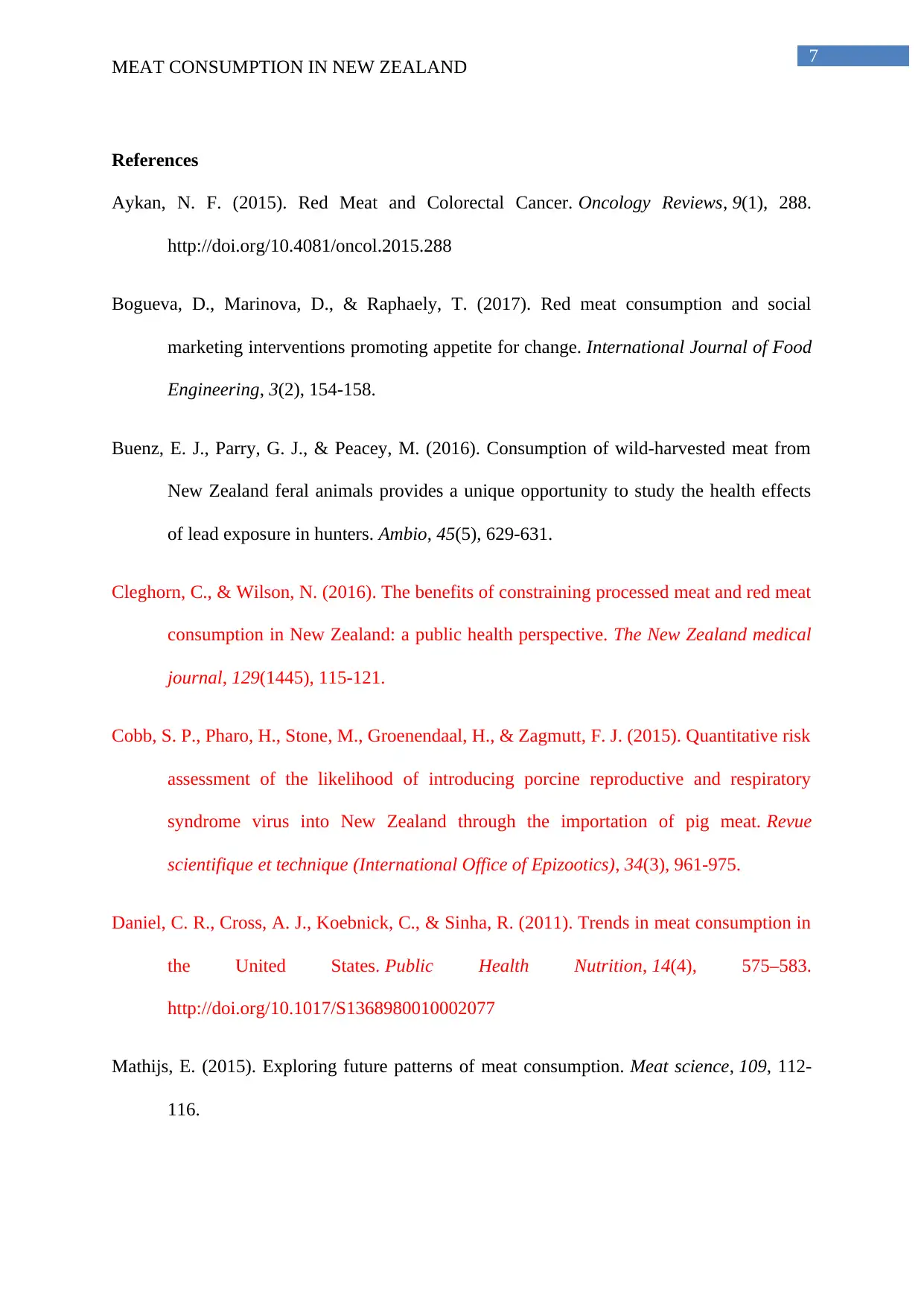
7
MEAT CONSUMPTION IN NEW ZEALAND
References
Aykan, N. F. (2015). Red Meat and Colorectal Cancer. Oncology Reviews, 9(1), 288.
http://doi.org/10.4081/oncol.2015.288
Bogueva, D., Marinova, D., & Raphaely, T. (2017). Red meat consumption and social
marketing interventions promoting appetite for change. International Journal of Food
Engineering, 3(2), 154-158.
Buenz, E. J., Parry, G. J., & Peacey, M. (2016). Consumption of wild-harvested meat from
New Zealand feral animals provides a unique opportunity to study the health effects
of lead exposure in hunters. Ambio, 45(5), 629-631.
Cleghorn, C., & Wilson, N. (2016). The benefits of constraining processed meat and red meat
consumption in New Zealand: a public health perspective. The New Zealand medical
journal, 129(1445), 115-121.
Cobb, S. P., Pharo, H., Stone, M., Groenendaal, H., & Zagmutt, F. J. (2015). Quantitative risk
assessment of the likelihood of introducing porcine reproductive and respiratory
syndrome virus into New Zealand through the importation of pig meat. Revue
scientifique et technique (International Office of Epizootics), 34(3), 961-975.
Daniel, C. R., Cross, A. J., Koebnick, C., & Sinha, R. (2011). Trends in meat consumption in
the United States. Public Health Nutrition, 14(4), 575–583.
http://doi.org/10.1017/S1368980010002077
Mathijs, E. (2015). Exploring future patterns of meat consumption. Meat science, 109, 112-
116.
MEAT CONSUMPTION IN NEW ZEALAND
References
Aykan, N. F. (2015). Red Meat and Colorectal Cancer. Oncology Reviews, 9(1), 288.
http://doi.org/10.4081/oncol.2015.288
Bogueva, D., Marinova, D., & Raphaely, T. (2017). Red meat consumption and social
marketing interventions promoting appetite for change. International Journal of Food
Engineering, 3(2), 154-158.
Buenz, E. J., Parry, G. J., & Peacey, M. (2016). Consumption of wild-harvested meat from
New Zealand feral animals provides a unique opportunity to study the health effects
of lead exposure in hunters. Ambio, 45(5), 629-631.
Cleghorn, C., & Wilson, N. (2016). The benefits of constraining processed meat and red meat
consumption in New Zealand: a public health perspective. The New Zealand medical
journal, 129(1445), 115-121.
Cobb, S. P., Pharo, H., Stone, M., Groenendaal, H., & Zagmutt, F. J. (2015). Quantitative risk
assessment of the likelihood of introducing porcine reproductive and respiratory
syndrome virus into New Zealand through the importation of pig meat. Revue
scientifique et technique (International Office of Epizootics), 34(3), 961-975.
Daniel, C. R., Cross, A. J., Koebnick, C., & Sinha, R. (2011). Trends in meat consumption in
the United States. Public Health Nutrition, 14(4), 575–583.
http://doi.org/10.1017/S1368980010002077
Mathijs, E. (2015). Exploring future patterns of meat consumption. Meat science, 109, 112-
116.
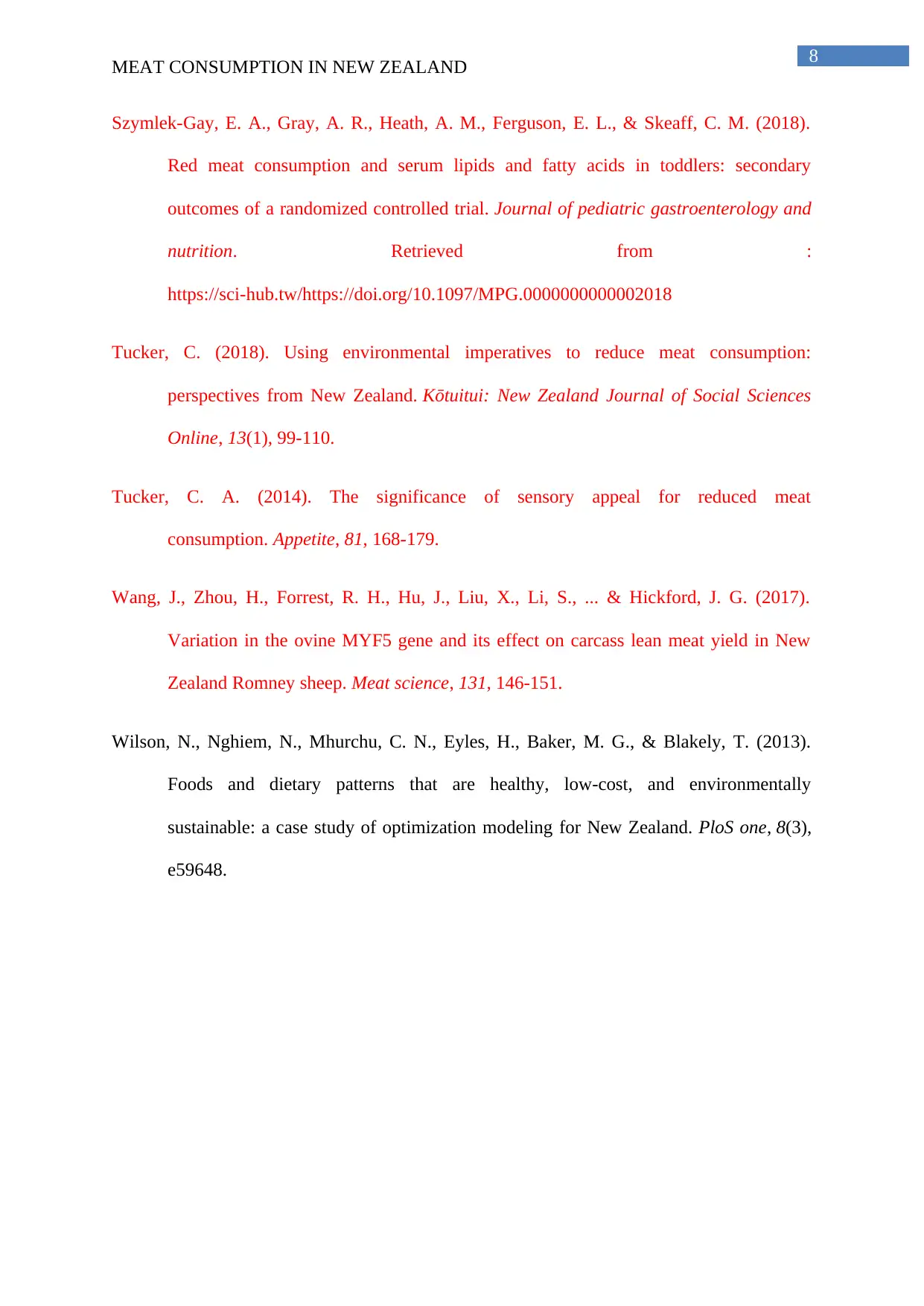
8
MEAT CONSUMPTION IN NEW ZEALAND
Szymlek-Gay, E. A., Gray, A. R., Heath, A. M., Ferguson, E. L., & Skeaff, C. M. (2018).
Red meat consumption and serum lipids and fatty acids in toddlers: secondary
outcomes of a randomized controlled trial. Journal of pediatric gastroenterology and
nutrition. Retrieved from :
https://sci-hub.tw/https://doi.org/10.1097/MPG.0000000000002018
Tucker, C. (2018). Using environmental imperatives to reduce meat consumption:
perspectives from New Zealand. Kōtuitui: New Zealand Journal of Social Sciences
Online, 13(1), 99-110.
Tucker, C. A. (2014). The significance of sensory appeal for reduced meat
consumption. Appetite, 81, 168-179.
Wang, J., Zhou, H., Forrest, R. H., Hu, J., Liu, X., Li, S., ... & Hickford, J. G. (2017).
Variation in the ovine MYF5 gene and its effect on carcass lean meat yield in New
Zealand Romney sheep. Meat science, 131, 146-151.
Wilson, N., Nghiem, N., Mhurchu, C. N., Eyles, H., Baker, M. G., & Blakely, T. (2013).
Foods and dietary patterns that are healthy, low-cost, and environmentally
sustainable: a case study of optimization modeling for New Zealand. PloS one, 8(3),
e59648.
MEAT CONSUMPTION IN NEW ZEALAND
Szymlek-Gay, E. A., Gray, A. R., Heath, A. M., Ferguson, E. L., & Skeaff, C. M. (2018).
Red meat consumption and serum lipids and fatty acids in toddlers: secondary
outcomes of a randomized controlled trial. Journal of pediatric gastroenterology and
nutrition. Retrieved from :
https://sci-hub.tw/https://doi.org/10.1097/MPG.0000000000002018
Tucker, C. (2018). Using environmental imperatives to reduce meat consumption:
perspectives from New Zealand. Kōtuitui: New Zealand Journal of Social Sciences
Online, 13(1), 99-110.
Tucker, C. A. (2014). The significance of sensory appeal for reduced meat
consumption. Appetite, 81, 168-179.
Wang, J., Zhou, H., Forrest, R. H., Hu, J., Liu, X., Li, S., ... & Hickford, J. G. (2017).
Variation in the ovine MYF5 gene and its effect on carcass lean meat yield in New
Zealand Romney sheep. Meat science, 131, 146-151.
Wilson, N., Nghiem, N., Mhurchu, C. N., Eyles, H., Baker, M. G., & Blakely, T. (2013).
Foods and dietary patterns that are healthy, low-cost, and environmentally
sustainable: a case study of optimization modeling for New Zealand. PloS one, 8(3),
e59648.
⊘ This is a preview!⊘
Do you want full access?
Subscribe today to unlock all pages.

Trusted by 1+ million students worldwide

9
MEAT CONSUMPTION IN NEW ZEALAND
MEAT CONSUMPTION IN NEW ZEALAND
1 out of 10
Related Documents
Your All-in-One AI-Powered Toolkit for Academic Success.
+13062052269
info@desklib.com
Available 24*7 on WhatsApp / Email
![[object Object]](/_next/static/media/star-bottom.7253800d.svg)
Unlock your academic potential
Copyright © 2020–2025 A2Z Services. All Rights Reserved. Developed and managed by ZUCOL.




